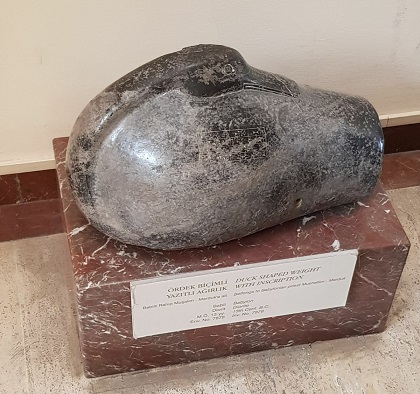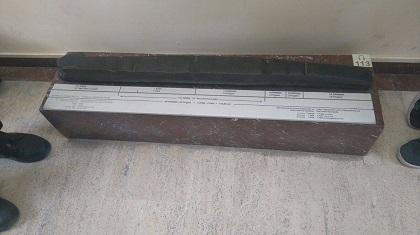Weights and measurements in the Bible
In the Bible, the concept of measurements and weight are intricately connected to the idea of judgement.
04 MARCH 2020 · 09:40 CET

One of the most interesting collections housed in the Istanbul Archaeology Museum is the collection of ancient weights and measurements. Talents, minas, shekels, and cubits are archaic terms that we as modern readers of the Bible are not very familiar with.
Often we look at tables and measurements found at the end of Bibles with much bewilderment. To complicate matters even more, when studying antiquity we realize that many civilizations had 2 or more different systems of measures and weights.
For example royal cubits typically tended to measure 50-52 cm. These cubits where used in major construction projects like palaces and temples and other official matters. Commoners however used a shorter version of the cubit named the common cubit in their day to day transactions such as the buying of fabrics, etc. This common cubit measured approximately 44-46 cm. Also known as half a yard, the measurement for the common cubit was based on the length from the elbow to the tip of the index finger.

Weight measurements were even more confusing. In ancient Babylon 4 classes of weights existed. The royal heavy weight, the royal light weight, the common heavy weight, and the common light weight! As far as royal weights are concerned the heavy talent = 60,600 grams; the mina (1/60 talent) = 1,010 grams; the shekel = 16.83 grams; the light talent = 30,300 grams; the light mina = 505 grams; the light shekel = 8.41 grams.
Both the heavy and light versions of these royal weights were represented with certain differences in order to reduce confusion. For example, the light talent would be given the shape of a duck, and the heavy talent would be given the shape of a lion. One such duck shaped talent weighing 30 kg is in displayed under inventory #7878 in the Istanbul Museum. The common heavy variants of weights were as follows: The talent weighed 58,944 grams; mina 982.4 grams; shekel 16.37 grams. The common light talent, mina, and shekel where half as much as their heavy counterparts.
According to Josephus, it was the heavy common talent that was the normal measure of weight in Syria and Judea. The Hebrews adopted the ancient Babylonian system but modified it. The mina came to be calculated as 50 shekels instead of 60. Josephus states that 1 Jewish mina (of 50 shekels) was equal to 2½ Roman pounds, or 818.62 grams; 1 shekel was equivalent to 16.37 grams, and 1 old mina of 60 shekels to 982.2 grams. ("Ant." xiv. 106, ed. Niese). According to this modified system, therefore, 60 minas or one heavy talent weighed 49.117 kg. A light talent would therefore weigh 24.5585 kg. The Romans also had their own measurements, such that their talent would approximately weigh 32 kg. It is difficult to assess which talent is in question when mentioned in the New Testament.

BIBLICAL SIGNIFICANCE
Weights and measurements are especially important in our understanding of biblical times and themes. Exacts measurements help us understand the dimensions of buildings such as Solomon’s temple. Weights are even more significant. In the absence of a monetary system like we have today, monetary values would be measured according to weights of gold or silver.
The lack of universal standardization, and the variety of different weight would no doubt would have caused confusion among those less educated or those lacking in acumen. To complicate matters even more, corrupt merchants would play with scales or shave off from weights to their own advantage. God had warned the people explicitly about such practices (Lev. 19:35-36, Deut. 25:13) But these practices became common place and put the poor and the commoners in unjust economic position. Many of the minor prophets echo ideas of God’s coming judgment upon Judah and Israel for reasons that include such economic practices (Amos 8:4-6, Hosea 12:7-8, Micah 6:10-14).
In the Bible, the concept of measurements and weight are intricately connected to the idea of judgement. Belshazzar was weighed on scales [...] and found lacking (Dan 5:27).
Talents also appear in several of Jesus’s parables concerning judgement. Among the most famous ones are the parable of the unforgiving servant (Matt. 18:21-35) and the parable of the talents (Matt. 25:14-30). Both of these parables have common themes. In each case the master is extremely generous and gracious, but in both parables one servant behaves irresponsibly, thus disrespecting the gift. In the first parable the evil servant takes God’s grace for granted and behaves unjustly against his neighbour. In the second parable, after receiving the talent that amounts to approximately 20 years of wages, the servant perhaps feels comfortable and does not invest in what is given to him. Even though this servant mentions the fear of God as the reason for his inaction, from the master’s reaction we glean that this is nothing more than a bad excuse for his laziness. With such parables Matthew seems to be emphasizing Jesus’ criticism of certain aspects of Jewish society. They were belittling the grace of God and making themselves objects of judgement.
This should be of warning to us today. God’s grace is not “cheap grace” as Boenhoffer would say. It is not an excuse for sin nor an excuse for inaction. If we are treating it as such, we too may be treading a dangerous path. Ultimately weight and measures remind us that God is holy, that he doesn’t stand for injustice and that we should be careful in how we treat our neighbour; for as Jesus says in Mark 4:24, “Pay attention to what you hear: with the measure you use, it will be measured to you…” (ESV).
Marc Madrigal is a Board member in the Istanbul Protestant Church Foundation in Turkey.
Bibliography:
Emil G. Hirsch, Immanuel Benzinger, Joseph Jacobs, Jacob Zallel Lauterbach. Weights and Measures. 1906. Jewish Encyclopedia. VXII. 483-490. http://www.jewishencyclopedia.com/articles/14821-weights-and-measures#217
John William Humphrey, John Peter Oleson, Andrew Neil Sherwood, Greek and Roman technology. 487.
Kinker, Thomas. Istanbul. Mit der Bibel durchs Museum. 2017. Verlag für Kultur und Wissenschaft Culture and Science Publ. 80-83.
Published in: Evangelical Focus - Archaeological Perspectives - Weights and measurements in the Bible
